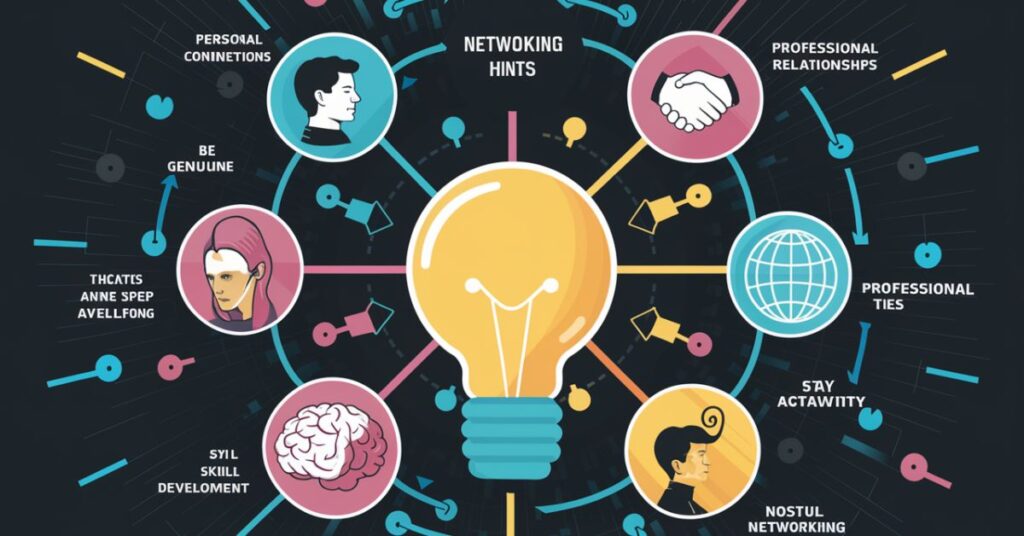In today’s fast-paced professional landscape, mastering the art of networking is crucial for career growth and success. This comprehensive guide will delve into the world of Connections Hints, an innovative approach to networking that combines strategic thinking with gamification principles. Whether you’re a seasoned professional or just starting your career journey, these insights will help you navigate the complex web of professional relationships with confidence and finesse. Explore Top Connections Hints for Effective Networking.
What are Connections Hints?
Connections Hints are strategic clues and guidelines designed to enhance your networking skills. Unlike traditional networking advice, these hints leverage modern psychology, game theory, and social dynamics to create more meaningful and lasting professional relationships.
Connections Hints differ from conventional networking tips in several key ways:
- They emphasize strategic thinking over random interactions
- They incorporate gamification elements to make networking more engaging
- They adapt to current trends and technologies in real-time
- They focus on the quality of connections rather than the quantity
How to Play Connections Hints
Think of Connections Hints as a strategic game where your career advancement is the ultimate prize. Here’s how to play:
- Objective: Build a diverse, high-quality network of professional contacts
- Rules: Follow daily hints and themes to guide your networking efforts
- Scoring: Measure success by the strength and value of your connections, not just the number
- Time constraints: Balance long-term relationship building with quick, opportunistic networking
“Networking is not about just connecting people. It’s about connecting people with people, people with ideas, and people with opportunities.” – Michele Jennae
Gaming Guides for Networking Success
Applying game theory to networking can transform mundane interactions into exciting opportunities for growth. Here’s how to level up your networking game:
- Set clear objectives: Define what you want to achieve through networking
- Track progress: Use apps or journals to monitor your networking activities
- Reward milestones: Celebrate when you make significant connections or achieve networking goals
- Learn from failures: Analyze unsuccessful interactions to improve your strategy
Here’s a Hint for Today’s Connections Categories

Stay relevant in your networking efforts by aligning with current trends and events. For example:
- Tech Industry: Focus on AI and machine learning discussions
- Healthcare: Explore telemedicine and digital health innovations
- Finance: Engage in conversations about cryptocurrency and blockchain
Related Post: Explore Top Connections Hints for Effective Networking
Here Are Today’s Connections Hints Categories
- Industry Disruptors
- Sustainability Champions
- Remote Work Innovators
- Diversity and Inclusion Leaders
Tailor your networking approach to these categories to make more impactful connections.
What is the Answer to Connections Today?
The key to successful networking lies in authenticity and mutual value. Instead of approaching networking with a “what can I get” mindset, focus on “what can I offer?” This shift in perspective can open doors to more meaningful and lasting professional relationships. Explore Top Connections Hints for Effective Networking.
Today’s Themes in Effective Networking
- Virtual Networking: Master the art of making connections in digital spaces
- Cross-Industry Collaboration: Seek opportunities to bridge different sectors
- Personal Branding: Develop a strong online presence that attracts connections
- Thought Leadership: Share insights to position yourself as an industry expert
How to Use Our NYT Connections Hints
The New York Times offers valuable insights into networking trends and strategies. Here’s how to leverage them:
- Stay informed: Regularly check NYT’s business and career sections
- Adapt insights: Tailor NYT’s advice to your specific industry and goals
- Combine approaches: Blend NYT’s insights with your networking style
What are Connections Hints by The New York Times?
The New York Times provides networking advice through various channels, including articles, interviews with industry leaders, and interactive features. These hints often reflect current business trends and offer actionable strategies for professionals at all levels.
Key features of Connections Hints include:
- Timely advice: Reflecting current market conditions and industry shifts
- Expert insights: Featuring perspectives from successful networkers and business leaders
- Practical strategies: Offering concrete steps for improving networking skills
- Industry-specific guidance: Tailoring advice to various professional sectors
The NYT Connections Hints Colors
The New York Times often uses a color-coding system in its networking advice to categorize different types of connections or strategies. While the specific colors may vary, here’s a general interpretation:
| Color | Meaning | Strategy |
|---|---|---|
| Green | New opportunities | Focus on growth and expansion |
| Blue | Professional development | Seek mentors and learning opportunities |
| Yellow | Creative collaborations | Look for innovative partnerships |
| Red | High-priority connections | Nurture relationships with key influencers |
Tips & Strategies for Playing Connections Hints
- Be genuine: Authenticity builds trust and lasting relationships
- Listen actively: Show genuine interest in others’ perspectives
- Follow up consistently: Maintain connections through regular check-ins
- Offer value: Look for ways to help your connections before asking for favors
- Diversify your network: Connect with people from various industries and backgrounds
Get to Know Your Trivia: Networking Edition
Expand your knowledge base to become a more engaging networker. Here are some areas to focus on:
- Industry trends: Stay updated on the latest developments in your field
- Current events: Have informed opinions on relevant news topics
- Cultural literacy: Understand diverse cultural references for global networking
- Company backgrounds: Research organizations before attending networking events
Daily and Seasonal Connections Hints
Adapt your networking strategy to different timeframes:
- Daily: Set a goal to make one new connection or strengthen an existing one each day
- Weekly: Attend or host a networking event or webinar
- Monthly: Conduct a network audit and reach out to dormant contacts
- Seasonally: Align networking efforts with industry events or conferences
- Annually: Set long-term networking goals and review your progress
Popular Sources for Connections Hints:

- LinkedIn Learning
- Harvard Business Review
- Meetup.com
- Industry-specific forums and communities
- Professional association websites
Color-Coded Groups: Network Segmentation
Organize your network into categories for more effective management:
- Green: Active collaborators and frequent contacts
- Yellow: Potential opportunities and growing relationships
- Red: High-value connections requiring special attention
- Blue: Mentors and industry leaders
- Purple: Cross-industry connections for diverse insights
Themed Hints: Networking with Purpose
Create themed networking events or challenges for yourself:
- “Tech Tuesday”: Focus on connecting with professionals in the tech industry
- “Mentor Month”: Dedicate a month to finding and nurturing mentor relationships
- “Cross-Industry Coffee Chats”: Set up meetings with professionals outside your field
Special Categories and Levels in Networking
Tailor your approach based on career stages and specializations:
- Entry-level: Focus on building a broad base of connections
- Mid-career: Seek mentorship opportunities and industry recognition
- Executive: Cultivate high-level strategic partnerships
- Entrepreneur: Network for funding, partnerships, and market insights
Unlimited and Accessibility in Networking
Break down barriers and create inclusive networking opportunities:
- Utilize online platforms to connect globally
- Attend virtual events to overcome geographical limitations
- Engage in mentorship programs for underrepresented groups
- Create accessible networking events considering various abilities
Gaming-Related Connections Hints
Leverage gamification in your networking strategy:
- Create a networking scorecard: Track and reward your networking activities
- Develop networking challenges: Set goals like “Connect with 5 industry leaders this month”
- Use AR for icebreakers: Integrate augmented reality apps at networking events
- Virtual networking worlds: Explore platforms like AltspaceVR for immersive networking experiences
Miscellaneous Connection Hints and Themes
- Skills-based networking: Connect based on complementary skills rather than job titles
- Volunteer networking: Build relationships through shared community service
- Alumni connections: Leverage your educational background for networking
- Social media challenges: Participate in industry-specific social media trends to increase visibility
Additional Resources for Networking Success
- CRM tools: Use customer relationship management software to track connections
- Networking apps: Explore apps like Shapr or Bumble Bizz for professional connections
- Online courses: Enroll in networking masterclasses on platforms like Coursera or Udemy
- Networking books: Read classics like “Never Eat Alone” by Keith Ferrazzi
Unique Hint Types for Standout Networking
- Story-driven introductions: Craft compelling narratives about your professional journey
- Value proposition networking: Clearly articulate what you bring to each connection
- Reverse mentoring: Offer to teach senior professionals about emerging trends or technologies
- Networking retreats: Attend or organize immersive networking experiences. Explore Top Connections Hints for Effective Networking.
Expert Tips: Mastering the Art of Connections
- Quality over quantity: Focus on building deeper, more meaningful connections
- Be a connector: Introduce people who could benefit from knowing each other
- Follow the 24-hour rule: Follow up with new connections within 24 hours
- Practice empathy: Try to understand and relate to others’ professional challenges
- Embrace rejection: Learn from unsuccessful networking attempts and refine your approach
Get Your Guesses Out of The Way: Networking Myths Debunked
| Myth | Reality |
|---|---|
| Networking is only for extroverts | Introverts can excel by leveraging their listening skills |
| You need a large network to be successful | A small, high-quality network can be more valuable |
| Networking is all about selling yourself | Effective networking focuses on building mutually beneficial relationships |
| Online networking isn’t as effective | Virtual networking can be highly impactful when done strategically |
FAQs: Demystifying Effective Networking
top 5 tips for networking
- Be authentic: Genuine interactions lead to stronger connections
- Offer value: Look for ways to help others before asking for favors
- Follow up consistently: Maintain relationships through regular check-ins
- Listen actively: Show genuine interest in other’s perspectives and experiences
- Diversify your network: Connect with people from various industries and backgrounds. Explore Top Connections Hints for Effective Networking.
What are the steps for effective networking?
- Define clear networking goals
- Research and identify relevant events or platforms
- Prepare your elevator pitch and personal brand
- Engage in meaningful conversations at events or online
What is a key aspect of effective networking?
A key aspect of effective networking is reciprocity. Building mutually beneficial relationships is crucial for long-term networking success. This involves:
- Offering help and support to your connections
- Sharing valuable information and resources
- Making introductions that benefit both parties
- Showing genuine interest in others’ success
What is an effective network?
An effective network is:
- Diverse: Includes connections from various industries and backgrounds
- Dynamic: Evolves and grows over time
- Mutually beneficial: Provides value to all parties involved
- Authentic: Built on genuine relationships and trust
- Strategically aligned: Supports your professional goals and aspirations





